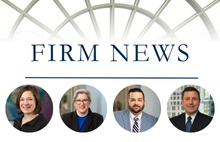Coronavirus (COVID-19) Impact on Immigration Compliance and Travel Restrictions
March 16, 2020With the coronavirus (COVID-19) declared a pandemic by the World Health Organization, federal, state, and local governments around the world are implementing travel bans and quarantine restrictions swiftly and without much warning. As employers implement work from home measures and limited travel policies, it is important to consider their impact on foreign nationals with employer-sponsored work visa status.
Impact of Work from Home for U.S.-Based Employees in TN and L-1 Status
Fortunately, short-term work displacements (resulting in working from home) for TN and L-1 employees, without a material change in other job duties, should not negatively affect the status of employees who are in TN and L-1 status. Thus, no new filings should be needed as long as the core, material job parameters stay the same, except for a changed job location.
Impact of Work from Home for U.S.-Based Employees in H-1B or E-3 status
Material changes to any H-1B or E-3 jobholder’s duties may require a new H-1B petition to be filed before such changes, and all employers are encouraged to contact their immigration counsel if such changes are contemplated. But, what are the implications of merely a geographic change to the position?
Fortunately, there are rules that touch on this, which are explored below. In sum, working from home (or a new worksite) could negatively affect the status of employees who are under H-1B, H-1B1, and E-3 status as these work visa status holders all require certified Labor Condition Applications (“LCAs”) on Form ETA-9035 that are specific to worksite locations, but, generally such placements are acceptable if limited in duration.
Place of Employment
The employer’s obligations under the H-1B regulations are focused around the H-1B worker’s place of employment and worksite. The employer must have an LCA on file for every place of employment or worksite. Per 20 CFR §655.715, “place of employment” is the worksite or physical location where the H-1B worker’s work is actually performed. Most H-1B program requirements (e.g., wages, posted notice) are tied to the place of employment and, thus, worksite(s).
Non-Worksite(s) (First Two Weeks)
There are also provisions for non-worksite locations for which there is no requirement to have an LCA on file, including training sites and short-term visit sites. The H-1B worker's presence at the locations to which he/she travels from the “home” worksite is on a casual, short-term basis, which can be recurring but not excessive (i.e., not exceeding five consecutive workdays for any one visit by a peripatetic worker, or 10 consecutive workdays for any one visit by a worker who spends most work time at one location and travels occasionally to other locations). In light of this latter provision, most workers suddenly working from home will be exempt from the LCA requirement for the first ten workdays at the new worksite.
Short-Term Placement (Up to 60 Days)
Short-term placement is a further regulatory exception to the usual requirements concerning worksite notice and prevailing wages. This exception provides an option that allows an employer to place an H-1B worker at a worksite within an area of employment not listed on existing LCA (i.e., non-LCA worksites). This option enables the employer to move its H-1B worker quickly to the worksite, without waiting to complete the LCA filing process. Thus, the employer is afforded some flexibility in the use of its H-1B workers to respond to business opportunities and needs. This provision may only be used for an H-1B nonimmigrant worker who is already in the United States and working for the employer (it cannot, for example, be used for someone coming to the U.S. for the first time to work in H-1B status).
A short-term placement will exist only if all of the following conditions are met:
- There is no strike/lockout in progress in the H-1B worker’s occupation at the short-term location;
- The employer does not already have an LCA on file for the geographic area of employment; and
- Placement of the individual H-1B worker at any site in an area of employment does not exceed 30 workdays (consecutive or non-consecutive) within a one-year period. Such placement may be for an additional 30 workdays, but for no more than 60 workdays, in a one year period, where the employer is able to show that the H-1B nonimmigrant maintains ties to the home worksite (e.g., a dedicated workstation at the permanent worksite; the employee’s abode is located near that worksite), and the worker spends a substantial amount of time at the permanent worksite.
What happens on the 31st day (or the 61st day, if applicable)?
If the employer still has no LCA on file for the geographic area of employment, the employer must remove the H-1B worker from the temporary worksite. If any worker exceeds the 30- or 60- day work limits, as applicable, the employer may no longer use the short-term placement option in that geographic area of employment for that year.
What can an employer do if it finds the short-term placement requirements do not meet its needs?
The employer may, at any time, file a new LCA for a worksite location change and perform all actions required in connection with that filing (e.g., determine the prevailing wage and post the notice for 10 consecutive business days). In most of these situations, the LCA may simply need to be posted in the home worksite, and a new H-1B petition does not need to be filed with USCIS; however, in other limited instances, an amended H-1B petition must be filed.
For any of these work from home arrangements, such situations should be discussed with immigration counsel before and during implementation. Moreover, H-1B employers should document any coronavirus instructions to employees, including their own instructions and those from third-party sites where H-1B workers may be stationed. This documentation will be helpful to confirm the timing and explain employer policies for any future LCA audits and H-1B site visits.
With the focus on containing the spread of the virus, it is unlikely that the government will challenge an employer taking reasonable precautions to protect its workforce and community while making every effort to maintain immigration compliance. As of now, neither the U.S. Citizenship & Immigration Services nor Department of Labor has provided any guidance for employers whose employees are subject to LCA worksite constraints.
Impact of International Travel Restrictions
Since COVID-19 began to spread worldwide, the United States has issued special restrictions on who can enter the country.
China and Iran Travel Restrictions
Immigrants and non-immigrant visitors who had been in China or Iran within 14 days of their attempted date of entry into the United States are not currently eligible to enter the United States. Citizens and lawful permanent residents of the US face special screening when they return to the country as well, if they have been in certain countries where COVID-19 is more widespread. Some people returning to or entering the US may be required to go into quarantine for at least 14 days; others may be asked to self-quarantine at home for two weeks after returning to the United States. Many other countries have imposed similar restrictions, extra screening, and quarantines.
European Travel Restrictions
The U.S. suspended travel from twenty-six European countries for 30 days, which went into effect as of March 13, 2020 for non-U.S. citizens. Initially, the U.K. and Ireland were specifically exempted from this 30-day travel suspension; however, as of March 14, 2020 those two countries were added to the list and travel will be suspended effective 11:59 p.m. eastern daylight time on March 16, 2020.
In addition to China and Iran, the full list of countries with travel restrictions now includes: Austria, Belgium, Czech Republic, Denmark, Estonia, Finland, France, Germany, Greece, Hungary, Iceland, Ireland, Italy, Latvia, Liechtenstein, Lithuania, Luxembourg, Malta, The Netherlands, Norway, Poland, Portugal, Slovakia, Slovenia, Spain, Sweden, Switzerland and the United Kingdom. The ban will be in effect for 30 days, and may very well be extended.
The 30-day restriction does not apply to U.S. legal permanent residents (green card holders), U.S. citizens, or to most immediate family members of U.S. citizens and permanent residents. The restriction also allows for the admission of other individuals where it is in the national interest to do so. Nevertheless, mandatory quarantines and extensive screenings for these exempt individuals continue. It is critical to take appropriate action as soon as possible. Citizens of the affected countries, including those currently in the U.S., should seek immediate solutions on a case-by-case basis concerning their current visa status.
Caution Regarding Visa Applications Abroad
Please note that some U.S. embassies and consulates may be limiting visa appointments and issuance. Some individuals from highly infected countries may try to apply for visas in third countries, but then may find it difficult to be readmitted into the U.S. if they also travel to any of the infected areas. Employers should be extremely careful about having employees travel internationally at this time.
Employees Unable to Return to Work in the U.S.
Employers should prepare for the possibility that employees may be unable to return to the United States because of travel or visa restrictions in response to coronavirus. In addition to government-mandated travel restrictions, many airlines have suspended operations to locations in China, Iran, and Italy, which have seen the highest number of confirmed cases of the illness. Some airlines have also reduced or suspended service to other specific countries. Employers who allow foreign national employees to work remotely while they are abroad should consider the employment laws of the country where the employee will be performing the work.
Employers are advised to communicate to their employees to reconsider international travel due to the travel restrictions in place and the possibility of expansion of restrictions — to other countries or in duration.
Our team of dedicated immigration attorneys are available in these difficult times to assist with finding unique solutions to your complex immigration needs and challenges.
In response to the coronavirus (COVID-19) pandemic, Lewis Rice has established a COVID-19 Task Force comprised of subject matter authorities, and stands ready to assist our clients navigate these challenging and evolving times. We continue to monitor the myriad legal and other developments that may impact our clients.
Resources
The Department of State has compiled a list of embassy websites for country-specific information concerning COVID-19.
The most recent list of countries impacted by the President’s international travel restrictions are included in the March 14, 2020 Proclamation.








